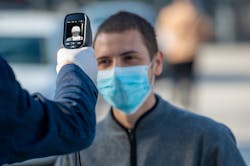COVID-19 pandemic will condense years of industry behavioral change, technology disruption
Editor’s note: This article originally appeared on Memoori.com and has been republished here with permission.
Within the last six months across the developed world, the tectonic plates of business have shifted fast – caused in large part by the need to overcome the COVID-19 pandemic through changes in people’s behavior. The world has subsequently entered uncharted waters and a deep recession. The good news is that these changes have given the physical security business some new growth opportunities.
Lifting lockdown in itself will not fully restore the economy and even if a vaccine was produced quickly, behaviors like online shopping and remote working are here to stay. The majority of OECD countries are now open for business, but consumers are still staying at home. While GDP is now returning to growth, we are a long way from economic recovery.
The physical security business has not suffered as severely as many others, partly because its products and services have been able to contribute to controlling the pandemic in buildings and the growing demand for delivering Video Surveillance as a Service (VSaaS) and Access Control as a Service (ACaaS). Customers, now with limited financial resources, are less likely to invest upfront in a “grudge purchase.”
COVID-19 has driven growth in “building wellness” systems as building operators are now in the process of installing a variety of products in preparation to meet the new standards for opening up their facilities. Demand for thermal cameras to detect the temperature of staff and visitors has grown fast and is now a multi-million-dollar business.
As part of a wider tracking and testing system they can provide employees and clients with a safer environment to work. COVID-19 has therefore directly delivered the physical security business a significant new growth opportunity. However, demand has recently fallen off as some suppliers have offered their systems as “fever cameras” when, in fact, thermal cameras can only detect body temperature.
The drive to improve the performance of physical security products will not be stunted by COVID-19. For example, video analytics software developments have now proven that they can deliver such benefits to users and that they will get a return on their investment.
In this challenging economy, customers will be demanding more value from their investments and will be less willing to commit to upfront capital expenditures. This is making ACaaS and VSaaS services even more attractive.
This shifts the investment off the building’s balance sheet, as the total service eliminates upfront capital expenditure. We also expect alliance and acquisition will become more important in strategic matters as opportunities open up during the next 24 months.
The industry now waits for Q3 financial results to find out how fast the industry will bounce back. At this time, the most optimistic scenario would be a return to pre-COVID business trading in Q2 2021 provided that the virus is contained by the end of 2020 and a proven vaccine is made available to the world by mid-2021.
Jim McHale is Managing Director of Stockholm-based market research firm Memoori.
About the Author

Jim McHale
Managing Director, Memoori
Jim McHale is managing director of Stockholm-based market research firm Memoori.
